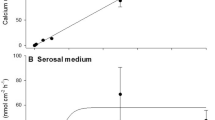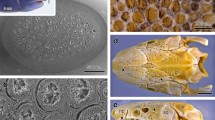Abstract
We measured Ca2+ exchanges across the skin of larval and adult Ambystoma tigrinum using the radio-isotope influx method. We found that the skin of both morphs takes up Ca2+ in a manner that is proportional to external [Ca2+], saturable and oriented against the electrochemical gradient for Ca2+. We conclude that this uptake occurs by active transport. Kinetic analysis yields affinities for calcium ions that are similar to the affinities for both Ca2+ and Na+ in the skin of other amphibians. The capacity for calcium is similar to Ca2+ capacity in other amphibians. The capacity for Ca2+ is lower than the capacity for Na+. Cutaneous Ca2+ deposits are lower in this urodele than found in anurans. Adults tend to have higher levels of Ca in their skin than do larvae.
Similar content being viewed by others
Author information
Authors and Affiliations
Additional information
Accepted: 25 June 1999
Rights and permissions
About this article
Cite this article
Zerella, M., Stiffler, D. Active transport of Calcium ions in the skin of the salamander Ambystoma tigrinum. J Comp Physiol B 169, 481–486 (1999). https://doi.org/10.1007/s003600050245
Issue Date:
DOI: https://doi.org/10.1007/s003600050245




